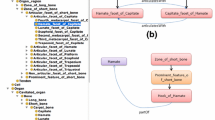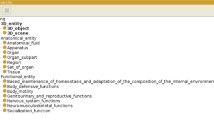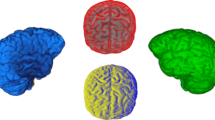Abstract
This paper presents a web-based three-dimensional (3D) navigation system for a spinal disease ontology using a 3D virtual human spine. The 3D navigation system consists of three main modules: a query module for finding spinal diseases and their causes and treatments from the spinal disease ontology via a web page, a 3D rendering module for rendering the virtual human spine on a web browser, and a visualization module to view the retrieved ontology information by connecting it with the virtual human spine. It was implemented using Virtuosos SPARQL, Java, JavaScript, Jena API, JDBC, AJAX, HTML5, WebGL, and SVG using a Virtuoso server on the Web via JSP web pages. Spine specialists can navigate and simulate spinal diseases using the 3D navigation system via virtual experiments based on the ontological interrelations, allowing them to make more accurate diagnoses of spinal diseases.












Similar content being viewed by others
References
Kim GH, Kang MJ, Jung CY, Jung JY, Jung SE, Kim JS, Jeong JS, Kim DH, Yoo KH, Seo DM, Lee SW, Lee SB, Lee SH, Kim SK (2013) Development of Ontology for the Diseases of Spine. In: Jeon HY, Obaidat MS, Yen NY, Park JJ (eds.) CSA 2014. LNEE, 279:1171–1178. Springer, Heidelberg
Lee SB, Lee SH, Seo DM, Yoo K-H, Kim SK (2014) Development of ontology and 3D software for the diseases of spine. Adv Multimed 420848:1–4
Pfirrmann CWA, Metzdorf A, Zanetti M, Hodler J, Boos N (2001) Magnetic resonance classification of lumbar intervertebral disc degeneration. Spine 26(17):1873–1878
Modic MT, Ross JS (2007) Lumbar degenerative disk disease. Radiology 245(1):4361
Weishaupt D, Zanetti M, Boos N, Hodler J (1999) MR imaging and CT in osteoarthritis of the lumbar facet joints. Skelet Radiol 28(4):215–219
Koper R (2004) Use of the semantic web to solve some basic problems in education: increase flexible, distributed lifelong learning, decrease teachers workload. J Interact Media Educ 6:1–23 Special Issue on the Educational Semantic Web
Vaccaro AR, Koerner JD, Radcliff KE, Oner FC, Reinhold M, Schnake KJ, Kandziora F, Fehlings MG, Dvorak MF, Aarabi B, Rajasekaran S, Schroeder GD, Kepler CK, Vialle LR (2016) AOSpine subaxial cervical spine injury classification system. Eur Spine J 25(7):2173–2184
Dean M, Schreiber G(2004) OWL Web Ontology Language Reference. Technical report, World Wide Web Consortium (W3C)
SemanticWorks Semantic Web Tool, http://altova-semanticworks.soft112.com/, http://www.altova.com/documents/SemanticWorksdatasheet
Protege, http://protege.stanford.edu/
Neches R, Fikes R, Finin T, Gruber T, Patil R, Senator T, Swartout WR (1991) Enabling technology for knowledge sharing. AI Mag 12(3):36–56
Gruber TR (1993) Adaptive a translation approach to portable ontology specification. Knowl Acquis 5(2):199–220
Genesereth MR, Nilsson NJ (1987) Logical foundation of artificial intelligence. Morgan Kaufmann, Los Altos
Kim M, Choi SY (2010) An Ontology-based Adaptive Learning System to Enhance Self-directed Learning. In: Kang, B.H., Richard, D. (eds.) PKAW2010. LNCS, 6232:91–102. Springer, Heidelberg
Lee W, Leung Carson K-S, Lee JJ (2011) Mobile web navigation in digital ecosystems using rooted directed trees. IEEE Trans Ind Electron 58(6):2154–2162
Song MH, Jeong JS, Kim M, Lee SH, Choi SS, Choi ES, Doung C, Yoo KH (2015) An ontology navigation system for 3D spinal model. ACM BigDAS 2015. New York, USA, pp 277–279
SPARQL 1.1 Query Language. W3C Recommendation 21 March 2013, https://www.w3.org/TR/sparql11-query/
Virtuoso, http://en.wikipedia.org/wiki/Virtuoso_Universal_Server
VirtuosoUniversalServer, http://www.w3.org/wiki/VirtuosoUniversalServer
Scable Vector Graphics, https://www.w3.org/Graphics/SVG/
WebGL Specification, https://www.khronos.org/webgl/
Three.JS, http://www.threejs.org/
Stedmans Medical Dictionary, http://www.lww.com/stedmans
KOSTOM (Korean Standard Terminology of Medicine), http://61.78.109.24/KOSTOM/
FMA (Foundational Model of Anatomy Ontology), http://fme.biostr.washington.edu/FME/index.html
Acknowledgements
This research was supported by Basic Science Research Program through the National Research Foundation of Korea (NRF) funded by the Ministry of Education (2014R1A1A2055379) and by the MSIP(Ministry of Science, ICT and Future Planning), Korea, under the ITRC(Information Technology Research Center) support program (IITP-2016-H8501-16-1013) supervised by the IITP(Institute for Information & communication Technology Promotion).
Author information
Authors and Affiliations
Corresponding author
Rights and permissions
About this article
Cite this article
Jeong, JS., Song, MH., Lee, SH. et al. A web-based 3D ontology navigation system for spinal disease diagnosis. J Supercomput 75, 4505–4518 (2019). https://doi.org/10.1007/s11227-017-1975-0
Published:
Issue Date:
DOI: https://doi.org/10.1007/s11227-017-1975-0




